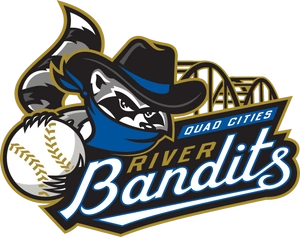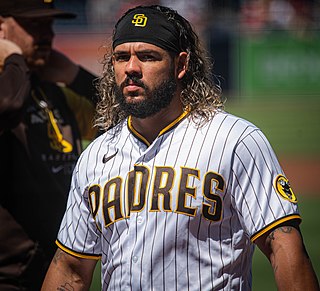
The Quad Cities River Bandits are a Minor League Baseball team of the Midwest League and the High-A affiliate of the Kansas City Royals. Their home games are played at Modern Woodmen Park in Davenport, Iowa, one of the Quad Cities.

A bobblehead, also known by nicknames such as nodder, wobbler, or wacky wobbler, is a type of small collectible figurine. Its head is often oversized compared to its body. Instead of a solid connection, its head is connected to the body by a spring or hook in such a way that a light tap will cause the head to move around, or "bobble," hence the name.

Lewis Robert "Hack" Wilson was an American Major League Baseball player who played 12 seasons for the New York Giants, Chicago Cubs, Brooklyn Dodgers and Philadelphia Phillies. Despite his diminutive stature, he was one of the most accomplished power hitters in the game during the late 1920s and early 1930s. His 1930 season with the Cubs is widely considered one of the most memorable individual single-season hitting performances in baseball history. Highlights included 56 home runs, the National League record for 68 years; and 191 runs batted in, a mark yet to be surpassed. "For a brief span of a few years," wrote a sportswriter of the day, "this hammered down little strongman actually rivaled the mighty Ruth."

Ebbets Field was a Major League Baseball stadium in the Flatbush section of Brooklyn, New York. It is mainly known for having been the home of the Brooklyn Dodgers baseball team of the National League (1913–1957). It was also home to five professional football teams, including three NFL teams (1921–1948). Ebbets Field was demolished in 1960 and replaced by the Ebbets Field Apartments, the site's current occupant.

Cricket clothing and equipment is regulated by the laws of cricket. Cricket whites, sometimes called flannels, are loose-fitting clothes that are worn while playing cricket so as not to restrict the player's movement. Use of protective equipment, such as cricket helmets, gloves and pads, is also regulated.

Steve Rushin is an American journalist, sportswriter and novelist. He was named the 2005 National Sportswriter of the Year by the National Sportscasters and Sportswriters Association, and is a four-time finalist for the National Magazine Award.

Floyd Caves "Babe" Herman was an American professional baseball player and scout. He played in Major League Baseball (MLB) as a right fielder between 1926 and 1945, most prominently as a member of the Brooklyn Dodgers who were known as the Robins at that time. After his most productive years with the Robins, he ended his playing career playing for the Cincinnati Reds, Chicago Cubs, Pittsburgh Pirates and the Detroit Tigers.

Ten Cent Beer Night was a promotion held by Major League Baseball's Cleveland Indians during a game against the Texas Rangers at Cleveland Stadium on June 4, 1974. The promotion was meant to improve attendance at the game by offering cups of low-alcohol beer for just 10 cents each, a substantial discount on the regular price of 65 cents, with a limit of six beers per purchase but with no limit on the number of purchases made during the game.

Jimmy "Browntown" Boyle, a catcher for the 1926 New York Giants, has the distinction of having one of the shortest known Major League Baseball careers. Although Boyle is only one of about 900 ballplayers who have played in only a single major league game, he is distinguished by having played for only one inning, the ninth inning of a game against Pittsburgh in June of that year. After three outs, Boyle never got to bat and never played again; he is even further distinguished by having never played in the minors, moving straight to the Giants from college. He asked manager John McGraw for his release and it was granted August 2, 1926.
The 1899 St. Louis Perfectos season was the team's 18th season in St. Louis, Missouri and their eighth season in the National League. The Perfectos went 84–67 during the season and finished fifth in the National League.
The 1953 Brooklyn Dodgers repeated as National League champions by posting a 105–49 record. However, Brooklyn again failed to capture the World Series, losing in six games to the American League champion New York Yankees.
The 1949 Brooklyn Dodgers held off the St. Louis Cardinals to win the National League title by one game. The Dodgers lost the World Series to the New York Yankees in five games.
On April 15, Jackie Robinson was the opening day first baseman for the Brooklyn Dodgers, becoming the first Black player in Major League Baseball. Robinson went on to bat .297, score 125 runs, steal 29 bases and win Major League Baseball's inaugural Rookie of the Year award. The Dodgers won the National League title and went on to lose to the New York Yankees in the World Series. This season was dramatized in the movie 42.
The 1938 Brooklyn Dodgers season was their 55th season. The team finished with a record of 69–80, finishing in seventh place in the National League. The 1938 season saw Babe Ruth hired as the first base coach, and lights installed by the team at Ebbets Field on June 15.
The 1920 Cleveland Indians season was the 20th season in franchise history. The Indians won the American League pennant and proceeded to win their first World Series title in the history of the franchise. Pitchers Jim Bagby, Stan Coveleski and Ray Caldwell combined to win 75 games. Despite the team's success, the season was perhaps more indelibly marked by the death of starting shortstop Ray Chapman, who died after being hit by a pitch on August 16.
The 1980 Detroit Tigers finished in fifth place in the American League East with a record of 84–78, 19 games behind the Yankees. They outscored their opponents 830 to 757. The Tigers drew 1,785,293 fans to Tiger Stadium in 1980, ranking 7th of the 14 teams in the American League. This was Sparky Anderson's first full season as Tigers manager.
The 1974 Cleveland Indians season was the team's 74th season in Major League Baseball. It involved the Indians competing in the American League East, where they finished fourth with a record of 77–85.

Erik Floyd Kratz is an American former professional baseball catcher who played for the Pittsburgh Pirates, Philadelphia Phillies, Toronto Blue Jays, Kansas City Royals, Houston Astros, Milwaukee Brewers, San Francisco Giants, Tampa Bay Rays, and New York Yankees during an 11-year career. Kratz was drafted by the Toronto Blue Jays in the 29th round of the 2002 Major League Baseball draft.

Jorge Mario Alfaro Buelvas is a Colombian professional baseball catcher who is a free agent. He has previously played in Major League Baseball (MLB) for the Philadelphia Phillies, Miami Marlins, San Diego Padres, Colorado Rockies, and Boston Red Sox. Alfaro signed with the Texas Rangers as a free agent in 2010, was traded to the Phillies in 2015, and made his MLB debut in 2016.










